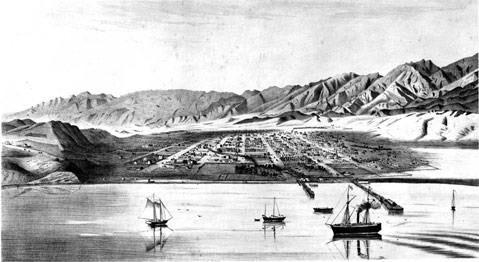‘What was Santa Barbara like in the 1850s?’
History 101

Question submitted by Joy Knapp
When California became a state in 1850, less than 20 percent of Santa Barbara’s population was Anglo and many of these inhabitants had adapted to life in Mexican California by converting to Catholicism, marrying into Californio families, and developing fluency in Spanish. As the Anglo minority continued to grow, social, political, and economic factors converged until, by the mid 1870s, Santa Barbara was a typical American town.
Attitudes toward the Californios began to shift in the late 1850s. New Anglo arrivals evidenced less desire to embrace Californio customs and some began to view these customs as outright threats. An interesting example of this shift may be seen in the journals of Charles Huse, an attorney who arrived in Santa Barbara in the early 1850s. He found the work ethic here suspect and also was highly skeptical of Catholicism. Yet, at the same time, he ingratiated himself with the wealthier of the old families, becoming especially close to the Carrillos.
The first challenges to the traditional power bases in the city’s political and judicial systems began in the mid 1850s, spurred by the Anglo-owned Gazette, the sole newspaper in town. Initially, the paper’s editors attempted to build bridges to the Spanish-speaking population. For a time, the paper printed a page in Spanish that, interestingly, offered items about events in Mexico rather than local affairs. The Spanish language page eventually disappeared as conflict between the two communities intensified-one of the major issues being bilingualism in the town’s school. A political shift had begun, although Californios would retain firm control of the local political power base well into the 1860s. Symptomatic of this was the fact that common council minutes continued to be recorded in Spanish until 1870.
Economic changes were also in the wind. The economy, based upon the beef cattle industry, had enjoyed tremendous prosperity in the late 1840s and early 1850s due to the gold rush, which had brought a huge influx of hungry newcomers into California. This demand for beef was petering out by the mid 1850s, leaving the rancheros in a vulnerable position. At the same time, Anglos were becoming more prominent in commercial and professional circles-positions enabling them to take advantage of the approaching economic shifts.
Flood followed by drought devastated the rancheros’ cattle herds in the early and mid 1860s. Despite promises made at the end of the war between the U.S. and Mexico, the rancheros were forced by U.S. courts to prove entitlements to their lands. Unable to pay taxes, mortgages, legal fees, and other mounting debts, and at times mystified by the American legal system, rancheros began to lose their holdings by default or were forced to sell land at rock-bottom prices. The result was a huge transfer of wealth into Yankee hands.
The percentage of Anglo Santa Barbarans continued to grow, and, by 1870, constituted a majority of the population. A speculative land boom and the beginnings of tourism saw ever larger numbers of Anglos arrive in the late 1860s and early ’70s. The area began to enjoy a reputation as a health resort and many who came for the “cure,” stayed.
The first local challenge to Californio political power had failed in the 1850s, as the Gazette was driven out of business. By the time of the local elections of 1873, the political scene had significantly changed. Californio leaders could still depend on a solid voting bloc, but it was now smaller than the Anglo electorate. When Anglos temporarily put aside their own political differences, the elections of 1873 saw the ouster of the Californios from every important local office.
In 1872, Stearns Wharf was completed, and in 1875, the Arlington Hotel opened for business; projects conceived by Anglo Barbare±os to benefit Anglo commercial interests. Santa Barbara was no longer a Californio pueblo, it was very much an American town. The transition had begun in the 1850s.



